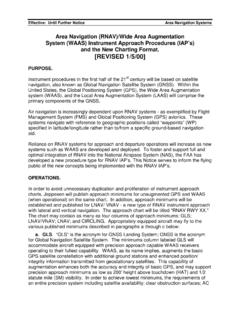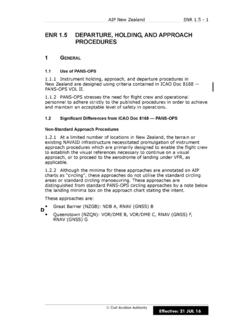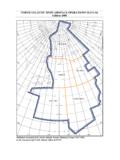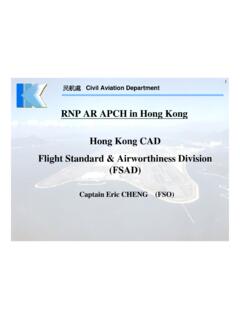Transcription of GPS Backbone of ADS-B ADS-B Backbone of NGATS
1 GPS Backbone of ADS-BADS-B Backbone of NGATSB riefing to Colorado Springs IOND ecember 11, 200911 December 2009 Overview Introduction ADS-B essential and critical services Navigation accuracy, integrity, & probability of non-detected integrity error Data links and spectrum ADS-B ground infrastructure deployment Summary211 December 2009 What does ADS-B stand for? Automatic aircraft & ground-based ADS-B equipment automatically broadcastsADS-B information Dependent ADS-B depends on GNSS signals, possibly with Flight Management System, for state vector Surveillance unprecedented situational awarenessof air traffic for ADS-B aircraft and ATC Broadcast ADS-B ground stations and aircraft periodically broadcastnavigation data and other flight information3 GPS is Backbone of ADS-B ADS-B is Backbone of the Next Generation Air Transportation System ( NGATS )11 December 2009 ADS-B Operational View4 December 20095 Why use ADS-B ?
2 Enables air traffic control procedures for more effective, efficient increased capacity and better routing Unprecedented pilot situational awarenesswith cockpit safety services; expands safe air traffic control services to cockpit Lower cost(estimated to be 10% of the cost of radar as well as air traffic efficiency time/money savings) More accurate(3-meters) and more frequent surveillanceinfrastructure (1 second vsup to 12 seconds for en route radar) Allows surveillance where previously not possible, Gulf of Mexico, mountains of AlaskaGround radar-based systemADS-B systemOn the ground, dependent on human participationOn the aircraft, providing automatic flow of ID & location dataCoverage gaps exist in some areasADS-B ground stations placed anywhere ( , mountains, oil rigs)
3 Positions updated by aircraft every 12 secondsPositions updated by aircraft every secondCostly to install and maintainSignificantly less costly to install and maintainSafety, cost/time savings, accuracy, expanded surveillance11 December 20096 Lower cost, more accurate & more frequent surveillance: ADS-B aircraft landing at OrlandoA/C on downwind phase heading south11 December 20097 Lower cost, more accurate & more frequent surveillance:A/C on final approachSSR delayA/C on down wind phase11 December 20098 What are critical ADS-B services? ADS-B : Aircraft broadcasts ADS-B messages, other ADS-B equipped aircraft receive these messages as well as the ground radio infrastructure for data delivery to ATC facilities ADS-R (Automatic Dependant Surveillance-Rebroadcast):translates for both ADS-B broadcast links 1090 MHz for air transport, military & high-end GA aircraft 978 MHz Universal Access Transceiver (UAT) for lower cost airborne avionics on aircraft flying below 24,000 feetFAA Source: December 20099 What are essential ADS-B services?
4 Traffic Information Services Broadcasts (TIS-B): provides air traffic situational awareness of non- ADS-B aircraft to ADS-B equipped aircraft Flight Information Service -Broadcast (FIS-B): provides current weather information and awareness of meteorological conditions that might impact flightFAA Source: December 200910 What is the TIS-B service? Traffic Information Services Broadcasts (TIS-B) ADS-B ground infrastructure ingests: All ADS-B broadcasts from aircraft FAA radar-based surveillance data for non ADS-B equipped aircraft TIS-B service broadcasts TIS-B messages on 1090ES & UAT Provides ADS-B aircraft with situational awareness by displaying data on all traffic in its proximity on a cockpit display11 December 2009 TIS-B Displays11 TIS-B in Anchorage Bowl on Garmin MX20 custom map in Anchorage Bowl area, round nosed targets are radar targets, arrow nosed targets are ADS-B equipped aircraft11 December 200912 TIS-B.
5 Unprecedented situational awareness with indications/alerts for safe operations in taxi &approach Cockpit Display of Traffic Information (CDTI) December 200913 TIS-B: Enables advanced ATC procedures such as conflict managementCockpit Display of Traffic Information (CDTI) December 200914 What is the FIS-B service? Flight Information Service -Broadcast (FIS-B) ADS-B ground infrastructure ingests: Weather data Aeronautical data FIS-B service broadcasts FIS-B messages on UAT only Pilots have an understanding of all weather and aviation system changes that might impact flight11 December 2009 FIS-B display15 Moving map display, FIS-B and terrain at Windy Pass, December 200916 How close can ATC space aircraft based on ADS-B ?
6 Merging & Spacing: ADS-B provides flight deck spacing for the safest, most efficient interval possible from cruise altitude to runway ATC can delegate aircraft separation responsibility to pilots with airspeed commandsImage of SafeRoute-M&S (Merging & Spacing) display courtesy of ACSSADS-B provides effective/efficient merging & spacing11 December 2009 GPS Accuracy & Integrity Parameters: NACp, NIC, and SIL Accuracyreflects nominal GPS performance; needed to avoid collisions and issue associated alerts Navigation Accuracy Category for Position (NACp) specifies the Estimated Position Uncertainty (EPU) with a 95% uncertainty bound Integrityreflects level of trust in GPS data; needed to provide a safe aircraft separation assurance Navigation Integrity Category (NIC) specifies integrity containment region characterized by horizontal radius of integrity containment (Rcor HPL) Probability of non-detected integrity errors; needed to assess aircraft maneuver risks and mitigate or avoid Surveillance Integrity Limit (SIL) specifies the probability of exceeding the NIC-specified integrity containment region17 NACp, NIC, and SIL 11 December 2009 Navigation Integrity Category (NIC) Parameter NIC derived from HIL/HPL Rc GPS-WAAS receiver NIC value function of WAAS differential data GPS-only receiver, RAIM algorithm (depends on mfg.)
7 Older units: fixed accuracy assumption assumes SA on Use URA in real-time to scale pseudorangeaccuracy18 NICH orizontal and Vertical Containment Bounds0 Unknown1Rc< km (20 NM)2Rc < km (8 NM)3Rc < km (4 NM)4Rc < km (2 NM)5Rc < 1852 m (1 NM)6Rc< m ( NM)7Rc < m ( NM)8Rc < m ( NM)9Rc < 75 m and VPL < 112 m10Rc< 25 m and VPL < m11Rc< m and VPL < 11mNIC value defines size of integrity region11 December 2009 Surveillance Integrity Limit (SIL) Parameter19 SILP robability of Exceeding the Horizontal Integrity Containment Radius (Rc) Without IndicationProbability of Exceeding the Vertical Integrity Containment Region (VPL) Without IndicationCorresponding Hazard Classification0 UnknownUnknownNo Safety Effect1 1 10-3per flight hour or per sample 1 10-3per flight hour or per sampleMinor2 1 10-5per flight hour or per sample 1 10-5per flight hour or per sampleMajor3 1 10-7 per flight hour or per sample 2 10-7per 150 seconds or per sampleSevere Major/Hazardous1 10-7 / hr reflects augmented GPS specification for Signal-in-Space integrity SIL corresponds to the probability of being outside the NIC Rccontainment region higher SIL value is better SIL is fixed during equipment installation & certificationSIL probability of being outside NIC integrity region11 December 2009 Navigation Accuracy Category for Position
8 (NACp) NACpderived from HFOM (95thpercentile accuracy) and is a weighted version of HDOP Estimated Position Uncertainty (EPU) NACpEPU < NIC Rcfor same NACp& NIC values20 Actual positionReported positionNACp: 95% bound on position accuracy (0-11)RcNIC: Integrity containment radius (0-11)SIL: probability actual position is outside NIC circle (0-3)NACp95% Containment Radius 0 EPU >= 10 NM1 EPU < 10 NM2 EPU < 4 NM3 EPU < 2 NM4 EPU < 1 NM5 EPU < NM6 EPU < NM7 EPU < NM8 EPU < NM9 EPU < 30 m10 EPU < 10 m11 EPU < 3 mEPUNACp 2 Navposition uncertainty region11 December 2009 GNSS position & Required Navigation Performance (RNP) RNP specifies the navigation performance necessary for operation within a defined airspace Aircraft certification specifies an accuracy level, such as RNP or RNP , at which the aircraft can navigate RNP X conveys that total Naverror X NM 95% of the time RNP specifies Navperformance required to fly air routes RNP requires alerts if performance not being met GNSS is current, primary navigation system for RNP21 GNSS equipment values NACp, NIC-SIL support RNP11 December 2009 RNP and ADS-B Enabled with GNSS PNT22 December 2009 ADS-B surveillance position validation ADS-B position (PADS-B) validated using any of three alternate, independent surveillance position sources (PIndep).
9 Radar data (primary, secondary, or both if available) One-way ranging on UAT targets Time difference of arrival (TDOA) when the target is received by more than one radio station Surveillance position validation threshold: Valid if Threshold NM for en route airspace, 36 s data window Valid if Threshold NM for terminal airspace, 15 s data windowThresholdPositionPositionsourcetIn dependenreportBADSA ircraft 23 ADS-B position validation with confidence11 December 200924 ADS-B Surveillance: deployed where previously notpossible ADS-B OUT avionics enable closer aircraft spacing Reduced Gulf separation from 120 NM to radar-like 5 NMADS-B position valid for en routeExample NACp, NIC, & SIL values: NACp 7 (EPU.)
10 1 NM) NIC 5 (Rc 1 NM) SIL 2 (Prob.(Rc NM) ) 10-5 ADS-B , NACp, NIC-SIL GPS data passed to ATC11 December 2009 What are key ADS-B data links? 1090 Mode-S Extended Squitter(ES) ATC stations and TCAS-equipped aircraft already have 1090 Mode S receivers and only require modifications to process ES data Due to data link bandwidth limits, 1090ES doesn t support FIS-B 1090 ES messages (120 bits, including 8 bit preamble) at 1 Mbps ES signals from Mode S transponders or non-transponder (NT) devices Universal Access Transceiver (978 MHz UAT) Designed for ADS-B and has greater bandwidth UAT is bi-directional and can send real-time Flight Information Services (FIS-B) such as weather and other data to aircraft UAT Frame (1 UTC second)





